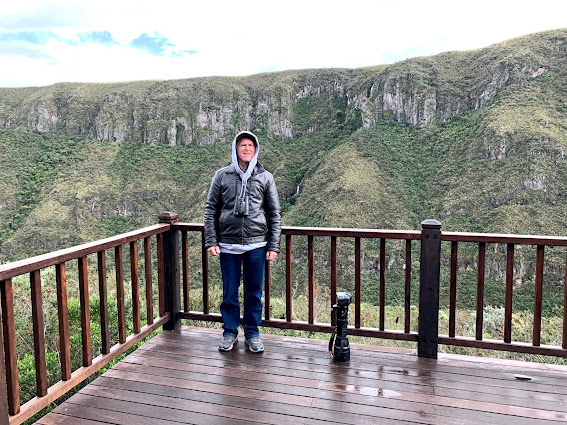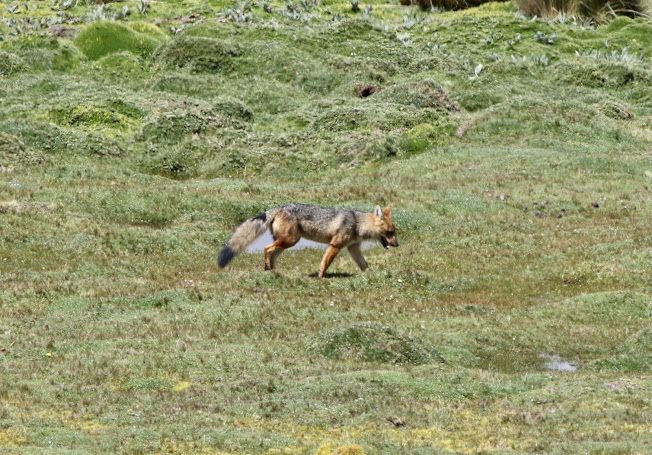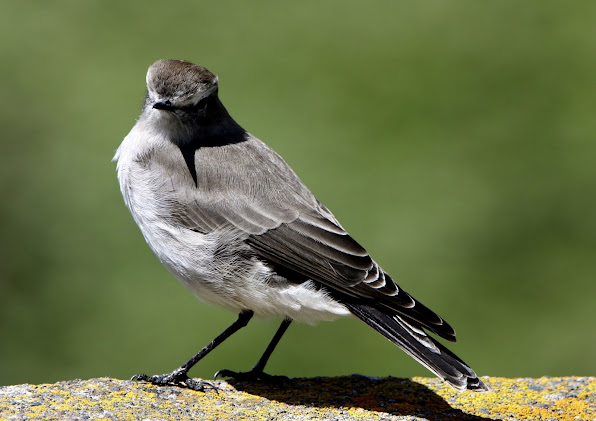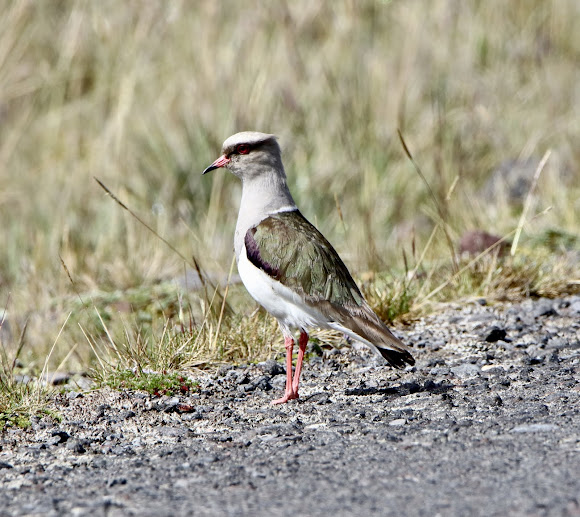3/25/21
If you watched that movie (Where Eagles Dare) some 50 years ago, you’d know I’d be writing about going up in the clouds, and you’d be correct. I had asked Javiar if he knew of any birders in the Quito area who could take me up to Antisana, up on the paramo east of the city where the Condors were. He put my name out to 3 such people, and I arranged with one of them to go there. His name was Alejandro Valenzuela. He picked me up at 5:45 AM and we were off to the high country.
I had been up here once before in 2009 after a church building venture, hiring Charlie Vogt, who works for Andean Birding. While the landscape had not changed, the ownership had gone from being privately owned to city owned, as this is where Quito gets much of it water supply. The final stretch of road getting there was horrendous, but once you reached where the city owned, the roads improved drastically.
We stopped at the well known restaurant called El Tambo, but there was no one there, and Alejandro thought it was strange as he had always found it open, even as early as we were there. We were going to tell them we’d be back at mid morning for brunch. It was then less than a mile to the overview where one can see condors taking off for the morning.
 |
| The cliff face where Condors roost. |
 |
| The Overlook to Watch for Condors. |
 |
| Black Flowerpiercer |
 |
| Cinerous Conebill |
Across the valley was a steep, rocky cliff face where they roosted and nested. We scanned the cliff face and spotted two birds. As I really wanted photos of one flying, it was just a matter of time. While waiting, the Black Flowerpiercers were active just below the observation deck, so I got a decent pic of one.
After about 10 minutes one took off and I snapped a series of shots. As the distance was massive, the bird is quite small in the photo, but I figured it was better than nothing and at least I would have the keepsake.
After a few more minutes the other one took flight, and next thing we knew there were 5 of them soaring high over the far hillside. They were being bombarded by Carunculated Caracaras, which were dwarfed by the size of the Condors. After all, an adult Condor stands at 4 feet tall and has a wing span of 12 feet.
So we continued “up” the road and of course up in elevation. One of the common standout birds here are the Carunculated Caracaras, supposedly in the falcon family but they don’t have any such agility. They are easily seen on the ground hunting for prey and we saw at least 50 of them today.
But they will also gather at the carcasses of dead animals with the Condors.
Another common bird of these heights is the Andean Lapwing, a large plover.
We did not see near as many as when I came up in ‘09, but fun to see none the less.
Some of the smaller birds flitting across the road were Sierra Slaty Finches, Thick-billed and Chestnut-winged Cinclodes.
 |
| Male Sierra Slaty Finch |
 |
| Female Sierra Slaty Finch |
 |
| Thick-billed Cinclodes |
There is a song about "Wide Open Spaces" but it really does not refer to landscapes. I thought about the tune, "Oh give me a home where the buffalo roam," but that would not do it either. The scenery alone was worth the trip there. Breathtaking! If only the clouds would life so the mountains could seen.
We stopped at a really small building which used to be the house of someone way back when. Only one hummer resides up this high, the Ecuadorian Hillstar. I was really hoping to get a pic of one, and Alejandro said they used to use that building to build their nests in. But he said it appeared that someone camped there and built a fire and he thought the smoke had deterred them as there were none there now. We later found a couple old nests which were pretty massive compared to the small hummers, and are hence easy to see.
As we were nearing a wet meadow where the Andean Ibis can usually be found, I spied what I thought was a very large bird on the hilltop to the north of us. Sure enough, it was a Condor. He stood out like a sore thumb, or so I thought. So I took a few pics and we drove another 100 meters to scan the wet meadow.
 |
| Andean Condor |
The Caracaras were thick here and we also saw our first Andean Gull.
 |
| Andean Gull |
While standing on the roadside, out of the corner of my eye, I noticed that the Condor had taken off. As I turned the dial on my camera for action shots, I said to Alejandro, “Here comes the Condor!” He would be flying past us, and the first series of shots I got were of him below the horizon. But as I knew this was a once in a lifetime opportunity I resumed the burst and the camera sounded like a machine gun for 5-6 seconds, and my total number of frames was almost 100. Here are a couple of the better ones.
 |
| Andean Condor |
 |
| Andean Condor |
 |
| Carunculated Caracara |
 |
| Carunculated Caracaras |
 |
| Carunculated Caracara |
 |
| Carunculated Caracara |
This area is named after the mountain Antisana, which is often shrouded in the clouds, but there was a short interval when we could see some of it, so we stopped and I took this pic. We could barely see the mountain:
We were now as high as we were going to get. I recorded the altitude with an app which said 13,245 feet, and the air was thin. The scenery was simply breathtaking.
We saw more Andean Gulls and a Paramo Pipit new graced my trip list.
We finally made it to the checkpoint where we parked. There was a calling Tawny Antpitta just above the parking lot who allowed a few pics.
 |
| Tawny Antpitta |
We then checked in at the guard station where I had to show my passport for them to write down my ID information. We walked around the buildings looking for Hillstar nests, but found only old ones. Alejandro concluded that they may have bred and dispersed, as we never did see one. We then walked about a half mile to an observation area overlooking the lake which is the main reservoir for Quito. We were forced to walk slowly, taking deep breaths. With not as much oxygen in the air I was certainly feeling light headed, so knew I had better take it easy.
Below the dam were some wild horses, remnants of the Conquistadors.
See that small fox with the horses? He is just to the left of the small white building.
Alejandro said you could distinguish the wild ones from the domestic ones as the wild ones did not look as healthy and the hooves were always needing a trimming.
Through binoculars I saw a small animal among the horses that turned out to be an Andean Fox, a nice bonus for having come this far. He was slowly making his way closer so here is a decent shot at about 250 meters.
 |
| Andean Fox |
Just before reaching the end of the trail I was able to get this pic of a Plain-capped Ground Tyrant.
 |
Plain-capped Ground Tyrant |
The way the wind blows up here, it forces the waterfowl to the end of the lake where we were. But the birds were still at least 200 meters from us. Below us, on the water were Andean Teal, Andean Coots, Andean Ruddy Ducks, Silvery Grebes and another Andean Gull.
By the time we made it back to the parking lot, I was really feeling the effects of the thin air, and walking was interrupted with short stops. We waited on a bridge over a small creek for a hummingbird to show up, but today they were a no show. A Variable Hawk did zoom over, so here he is:
 |
| Variable Hawk |
We finally got back in the car and retraced out route. It was nice to not be in a hurry and enjoy the scenery. It was more of the same for birds except for 3 Black-winged Ground Doves. As I’d been up here before I did not see any lifers, but did add at least 15 to the trip list.
We stopped at the El Tambo restaurant which was still closed, but we went around to the back side where some hummer feeders were placed and saw the Giant Hummingbird, the largest hummer coming in a 6 1/2 inches! It was a quick visit to a feeder or I would have loved to get his pic. Otherwise, the expected Shining Sunbeams, Sparkling Violet-ears and one male Great Sapphire wing were hogging the feeders.
 |
| Shining Sunbeam |
 |
| Sparkling Violetear |
One the way to a large mall where we’d eat, Alejandro took me to a reservoir where a large number of Yellow-billed Pintails could be found.
 |
| Yellow-billed Pintail |
One lone Which-cheeked Pintail was there, off by himself.
 |
| White-cheeked Pintail |
There were also a few Laughing Gulls there, and one Hooded Siskin.
It was then to the mall where we ate. By then I was not feeling the effects of the altitude of an hour ago, so that was a relief. It was then off to the airport. The flight to Guayaquil takes only a half hour, so you spend 90 minutes waiting to board the plane, another 30 in the plane, 30 in the air, and once you arrive you wait about 20 minutes to be unloaded from the plane. But it is still faster than taking the bus!
The first time Rosie and I flew into Quito, as soon as we got off the plane, we were struck immediately with altitude sickness, and she spent much of the next day in bed. I was worried about being affected when I flew into Quito this time, but I forgot all about it til we were half way to Mindo, and I realized it had not bothered me. The day before, Javiar said going to Yanacocha at 11,500 feet was good practice for going to Antisana. If a person hopes to go to these higher elevations he needs to figure out if he can deal with such, otherwise it is not fun.











No comments:
Post a Comment